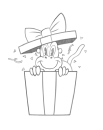Want more? Check out the full course for a deep dive into drawing the human form!
Give Yourself Permission to Be Bad
Many aspiring artists feel intense pressure to create amazing work right away. You often forget it’s okay to be bad as you learn. Think of a small child learning to walk, they stumble and fall, but they don’t feel embarrassed. Let yourself stumble, make mistakes, and grow naturally, rather than punishing yourself for every error.
Recognize Art as a Stack of Skills
Drawing, color theory, perspective, gesture, and more all require their own practice. Being an artist is not a single skill, it’s a stack of many overlapping skills. When you try to master everything at once, you can feel overwhelmed. Instead, look at each skill separately, and allow yourself to have an awkward phase in every new area you explore.
Chunk Down the Process
When you want to improve, break large tasks into small, manageable parts:
• Experiment with simple lines before you tackle beautiful tonal work.
• Use basic shapes (like tubes for arms) before you try detailed anatomy.
Focus on these smaller milestones to ease frustration and make steady progress.
Aim for Small Wins
If you set a massive goal and fall short, you’re more likely to feel like a failure. But if you aim for just a few minutes of focused practice and go beyond that, your brain rewards you with a sense of achievement. Over time, these small triumphs add momentum and lower resistance.
Use Visual Cues
Keep yourself on track by making your targets visible:
• Write your goals on a whiteboard or Post-it notes.
• Display artwork that inspires you.
Being a visual being, you’ll stay more motivated if you see your ambitions daily.
Stack Motivations
Fear-based goals, like wanting to prove yourself or earn a living, can help, but going deeper can motivate you more powerfully. Think about the joy you feel creating art or how your work might brighten someone else’s day. The more reasons you have to persist, the stronger your resolve becomes.
Cultivate Supportive Community
Finding like-minded people can help you see blind spots, and reduce the resistance in your own mind. When you join or form a community, either online or nearby, you gain fresh eyes to catch unhelpful scripts you might invent. Support and accountability keep you moving toward your goals.
Target Weaknesses Safely
Address your weak areas in small, focused increments. If proportions challenge you, spend a little time on just the joints of the fingers. Make it only slightly harder than what’s comfortable, about 4% tougher. This small stretch prevents overwhelm and still pushes you forward.
Balance Practice with Growth
A common approach is the 80/20 rule: 80% of your practice time focuses on what you’re already decent at, and 20% targets your weaknesses. Gently raise your skill level by turning those weaknesses into strengths, one small step at a time.
Reduce Stress to Increase Creativity
When you’re too stressed, you freeze or fight through your practice. Stress drains mental energy and blocks new ideas. By lowering stress with clear goals, manageable challenges, and positive self-talk, you’ll open up more room for creative solutions, personal style, and artistic growth.
Give yourself these incremental steps, and you’ll see your momentum gradually shift. Prioritize small, consistent wins, welcome each stage of learning, and allow yourself to learn without fear. Over time, you’ll notice your art practice leaning downhill rather than feeling like you’re constantly pushing uphill.
Want more? Check out the full course for a deep dive into drawing the human form!







